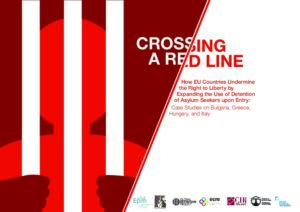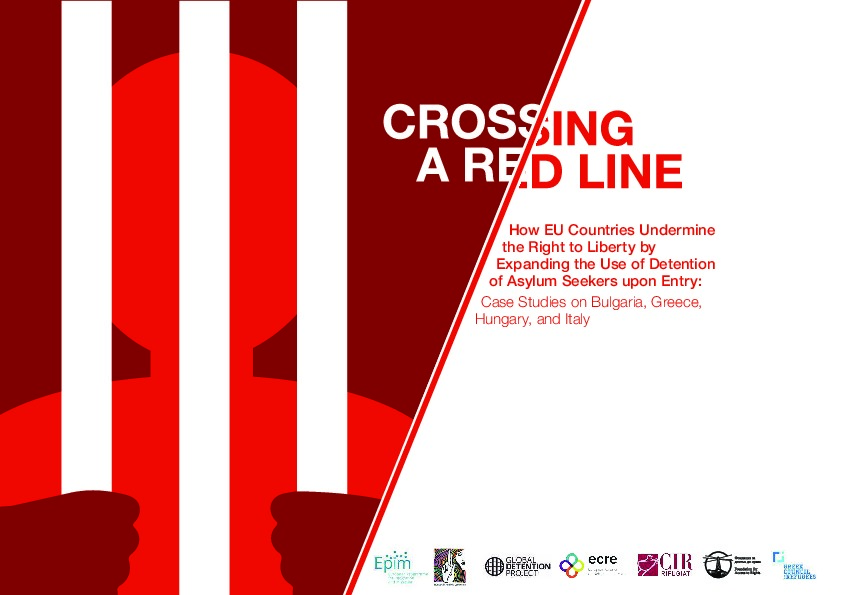In February 2019, the Hungarian Helsinki Committee (HHC) along with several partner organisations, including the Global Detention Project (GDP), launched the final report of their joint initiative, the Red Line project, whose objective is to document and raise awareness of how EU states’ border “reception” procedures are increasingly used for the detention of asylum seekers. Initially launched in 2017, the project received financial support from the European Programme for Integration and Migration (EPIM) and involved NGOs in Hungary (HHC), Bulgaria (Foundation for Access to Rights), Greece (Greek Council for Refugees), and Italy (Italian Council for Refugees).
The final report, “Crossing a Red Line: How EU Countries Undermine the Right to Liberty by Expanding the Use of Detention of Asylum Seekers upon Entry,” is based on assessments made by project partners of how the morphing of “reception” into “detention” at the borders of their countries is undermining asylum seekers’ right to liberty. The GDP’s role was to assist the project in using UN human rights mechanisms, like the Working Group on Arbitrary Detention, to raise awareness of these trends at the international level. In addition, the GDP worked individually with each national partner to use the GDP’s online database, the Global Immigration Detention Observatory, to develop comprehensive detention data profiles of each country’s key immigration detention-related indicators as well as operations at the main detention centres covered in the report (links to these data profiles are provided below).
The Red Line detention report was launched at an event hosted at Quaker House in Brussels on 6 February 2019, which included presentations by each country partner in addition to presentations by Elina Steinerte, vice-chair of the UN Working Group on Arbitrary Detention; Judith Sargentini, member of the European Parliament; the GDP’s Michael Flynn; ECRE’s Minos Mouzourakis; and HHC’s Gruša Matevžič.
KEY FINDINGS OF THE RED LINE DETENTION REPORT
- The use of detention upon entry increased in 2015 with the increase in the number of migrant arrivals, but it has continued to this date despite a significant decrease in asylum applications in Bulgaria, Hungary, and Italy.
- In 2017, 73.5% of asylum seekers were detained in Hungary (an increase from 2.9%) and 59% in Bulgaria, while the average length of detention has also increased in both countries.
- In 2017 the use of migrant detention increased in Italy by 25% and in Greece by 75%.
- The research revealed various practices of de facto detention, such as “protective custody” of children in Greece, hot spot detention in Greece and Italy, transit zone detention in Greece and Hungary, detention during pushback in Greece, detention on boats in Italy and detention in pre-removal centres in Greece. The common element in these forms of detention is that “de facto detention” occurs when individuals are deprived of their liberty in the absence of a detention order. Their confinement is not classified as detention under domestic law and their only possibility of release is by leaving to another country.
- The increased frequency with which asylum seekers are detained upon entry is motivated by a range of different practical, political, and legal considerations. It has been used as a general response to cope with unprecedented pressure on the reception and asylum processing systems in all of the countries studied (including as a response to the lack of open reception accommodation facilities in Bulgaria and Greece). Detention has also been promoted as a security measure (e.g. against terrorism) and used as a means to prevent asylum seekers from crossing external borders in a bid to gain political support for the ruling government (in Bulgaria, Hungary, and Italy).
- No clear evidence confirms that detention reduces the flow of arrivals as a response to an increased migratory pressure.
Global Immigration Detention Observatory Data Profiles (Appendix to the Red Line Detention Report)
- I. Bulgaria Profile (Lyubimets Detention Centre (Special Home for Temporary Accommodation of Foreigners and Sofia Busmantsi Detention Centre (Special Home for Temporary Accommodation of Foreigners))
- II. Hungary Profile (Roszke Transit Zone Detention Centre and Tompa Transit Zone Detention Centre)
- III. Greece Profile (Fylakio Pre-Removal Detention Centre and Samos Vathy Reception and Identification Centre)
- IV. Italy Profile (Trapani Pre-Removal Centre and Lampedusa (Contrada Imbriacola) Hotspot)




